Summer’s Watercolor Wonderland
USA Today
July 2007 issue Barbara’s The Collection on the cover

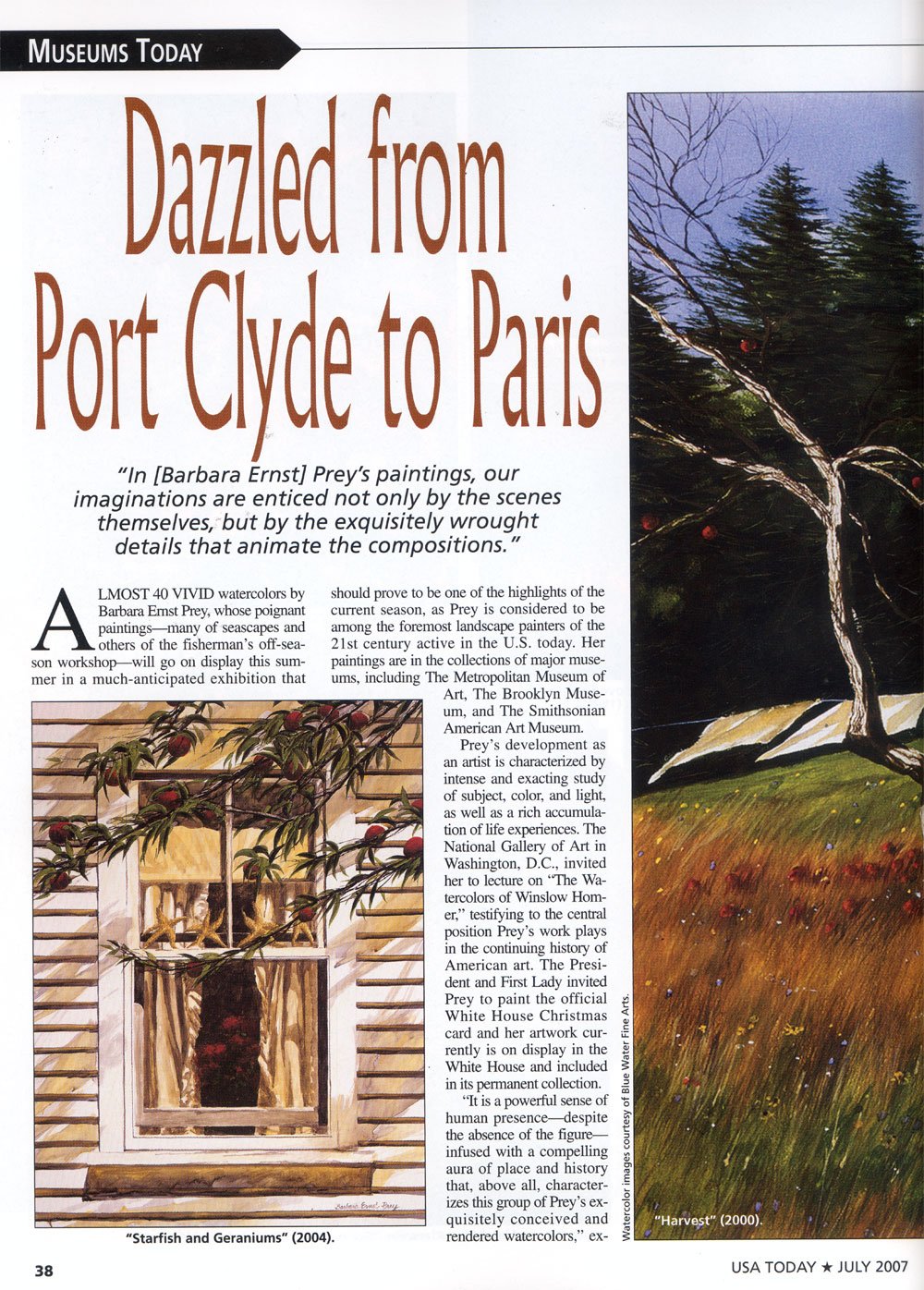
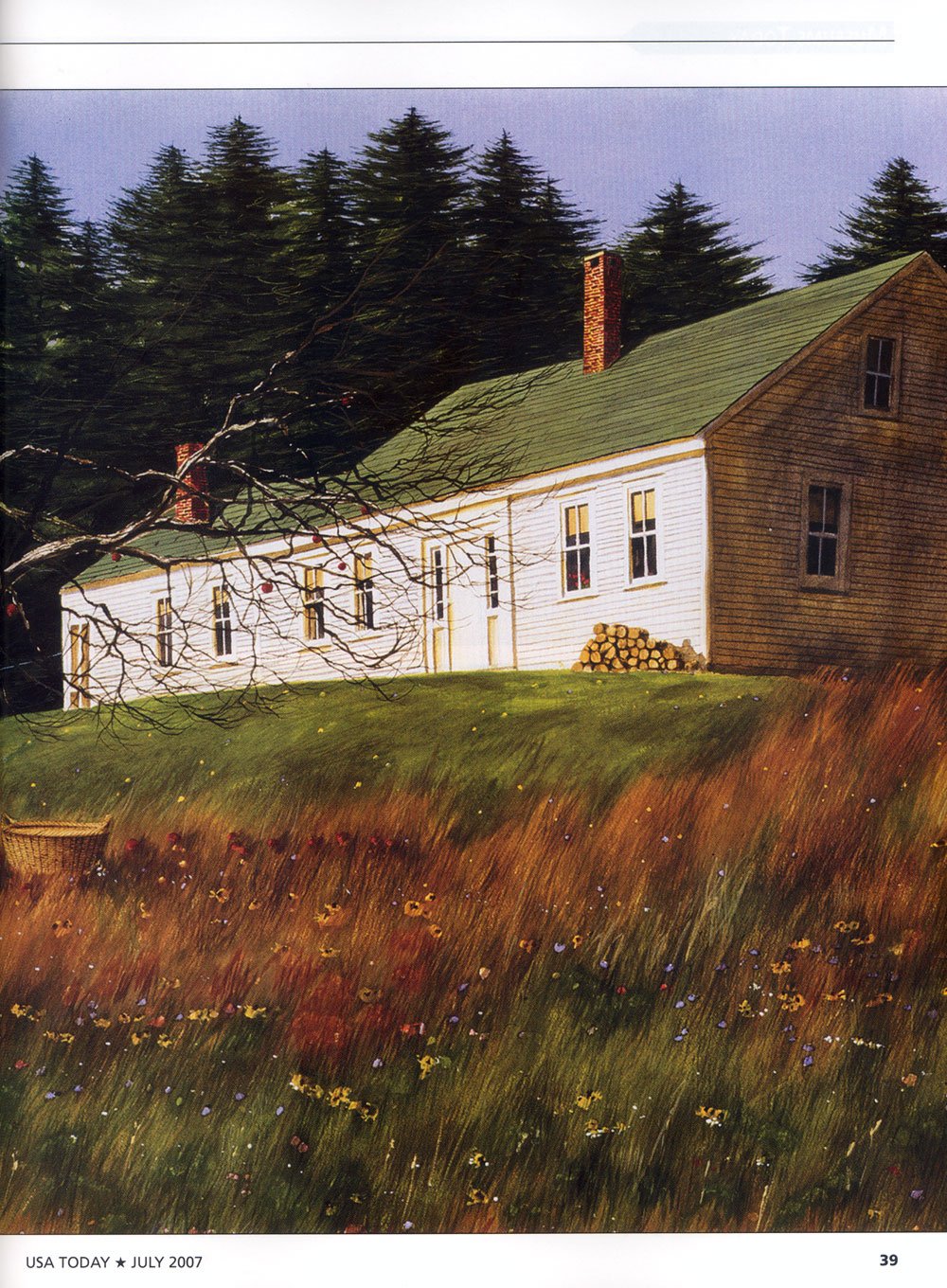
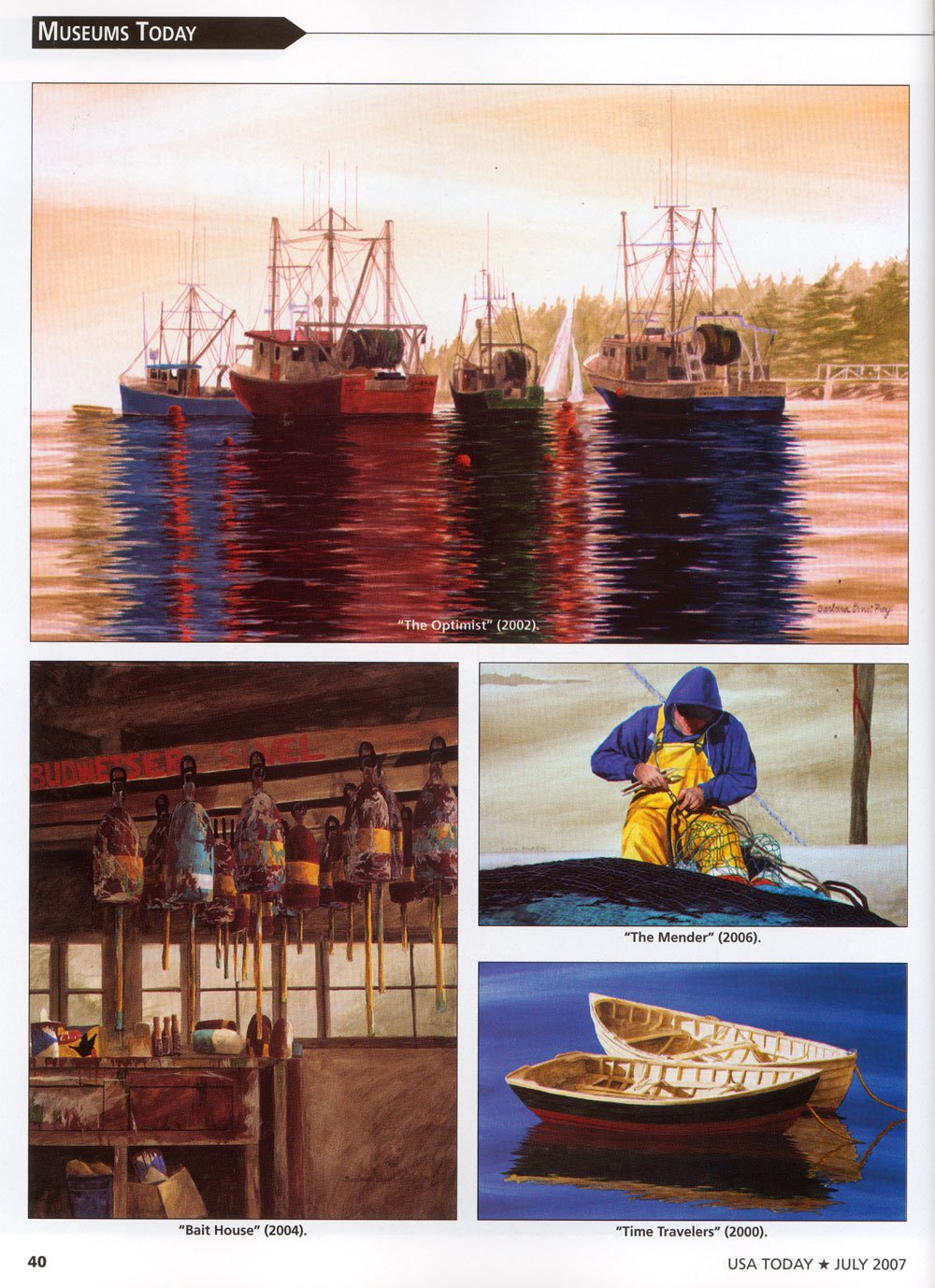
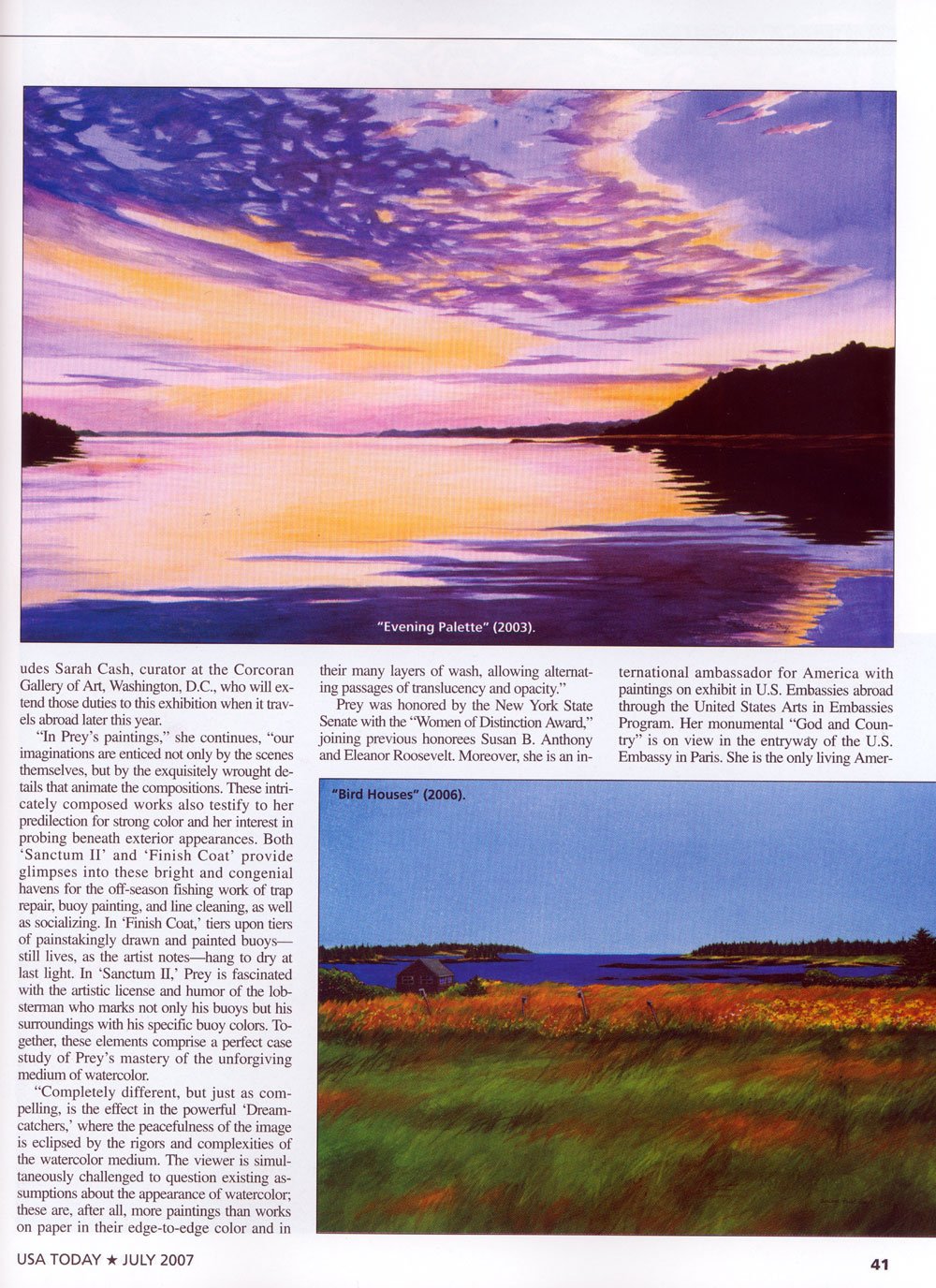

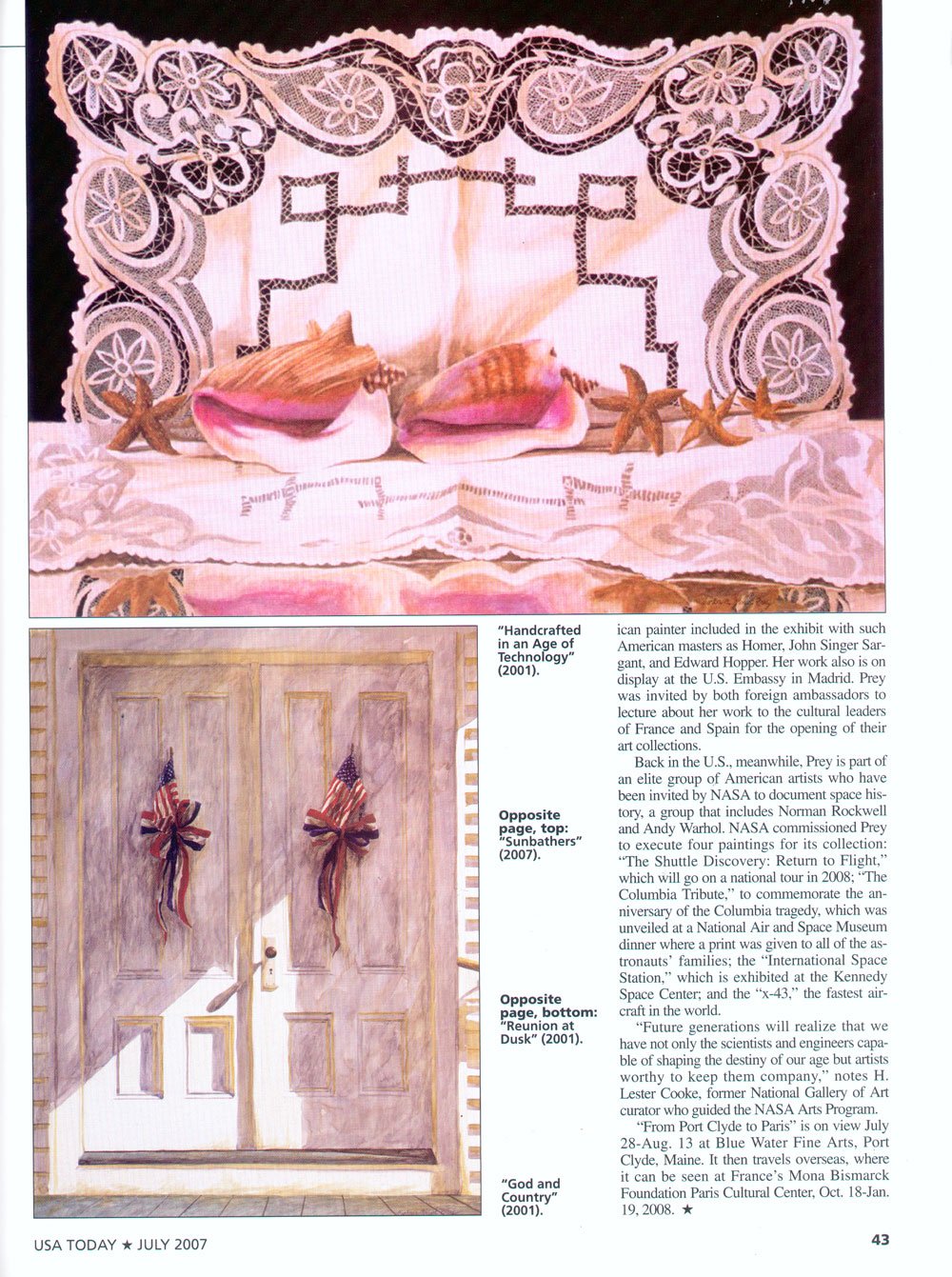
Early artwork for the renowned magazine The New Yorker, for which Prey illustrated over a ten year period, will be on display as will Prey’s contributions to the legendary newspaper, The New York Times. Early illustrations for Gourmet and Horticulture magazines can be viewed as well. Her painting “Columbia Tribute”, which was commissioned by NASA to commemorate the anniversary of the Columbia shuttle tragedy and is currently on exhibit at the Kennedy Space center, will also be included in the exhibit and shows the breadth of Prey’s talent. The Mona Bismarck Foundation hosting Prey’s retrospective is evidence of her international appeal. In 2003, Prey joined an elite group of artists who have been designated the honor of painting the White House Christmas Card, and her artwork, including the official print and studies for this prestigious undertaking can be viewed at the exhibit. Also, seven of Prey’s early sketchbooks are on display and contain sketches capturing Prey’s impressions of China, Italy, Germany, France, Africa, Switzerland, and Taiwan. These books illuminate Prey’s artistic process and allow one to view the transition of her work over the past 38 years. Prey was able to fill these sketchbooks due to her being the recipient of both a Fulbright Scholarship, which allowed her to travel and capture the sights of Europe, and a grant from the Henry Luce Foundation that enabled Prey to study with a Chinese master painter and to put her impression of the orient onto paper. Sarah Cash, Bechoefer Curator at the Corcoran Gallery of Art is the curator of the exhibit, who will also write the critical essay for the book accompanying the exhibit.
Prey’s exhibit is organized by the Paris Cultural Center of the Mona Bismarck Foundation and is located in the Countess’ former townhouse overlooking the Eiffel tower. Mona Von Bismarck was the first American to be named “Best Dressed Woman in the World” and Salvador Dali painted her portrait. The Mona Bismarck Foundation is a centerpiece of cultural and scholarly exchange between Europe and the Americas and has featured such previous exhibits as a Balenciaga exhibit—of which Hubert de Givenchy was the curator—and a Matisse exhibit curated by Pierre Schneider.
The Mona Bismarck Foundation hosting Prey’s exhibit is only one of the many honors she has garnered throughout the years of her career. NASA has commissioned her to paint four paintings to date, giving Prey a spot among such other accomplished artists as Norman Rockwell and Andy Warhol who have also documented space history for NASA through their work. Prey’s first NASA commission, in 2002-2003 was to render the International Space Station. Sky and Telescope Magazine assisted Prey in her research of the complexities and details of the Space Station. Prey normally does a lot of research before beginning a piece, particularly in this instance as the International Space Station has not been finished and NASA wanted a painting of the finished Space Station so Prey put together a model of the finished Space Station. Prey was also able to make a trip down to Kennedy Space Center and view a shuttle launch. Prey’s research paid off and NASA was so impressed with her artistic ability and talents that they asked her to do a painting to commemorate the Columbia tragedy. The Columbia Tribute painting sprung from this important undertaking and it now hangs beside two Andy Warhols, a Peter Max, an Annie Liebowitz, and Prey’s own International Space Station at the Kennedy Space Center in Florida. The Columbia Tribute painting was unveiled at the National Air and Space Museum anniversary Tribute dinner in Washington D.C. A print of the painting along with a quote from the President was presented to the families of the astronauts who perished in the tragic launch. This painting will be on exhibit in Prey’s Paris show. NASA was suitably impressed with Prey’s second addition to its gallery and asked her once more to do a painting, this time Prey would be placing the x-43, the fastest aircraft in the world, on paper. Prey’s research included a trip out to Edward’s Airforce Base to observe the x-43 in action. The painting of the x-43 will be included in the upcoming Smithsonian SITES exhibit in 2008 to celebrate the 50th anniversary of the NASA art collection. Only fifty works of art were chosen to be in the exhibit, which will travel around the country, and it is a testament to Prey’s immense capabilities as an artist that her work was included.
Prey’s fourth NASA commission was the Discovery Shuttle Return to Flight, the pair for the Columbia Tribute painting. Prey says about her research for her latest NASA endeavor, “NASA sent me photos, but I prefer to work from life. I was able to go down for the liftoff, which was majestic. I saw the Discovery Shuttle go up and up into the sky with a surreal reflection in the still water that was in front of me. No photograph could have captured that image or the spirit of the moment, and it was important for me to be able to experience that for the painting. I tried to connect the Columbia with the Discovery in the reflection in the water. I am an academic at heart and all of these NASA commissions were fascinating, not only did they challenge me creatively but they expanded my world intellectually.” Dr. H. Lester Cooke, former National Gallery of Art Curator who guided the NASA Arts Program comments, “future generations will realize that we have not only the scientists and engineers capable of shaping the destiny of our age, but artists worthy to keep them company.”
Prey is one of the foremost landscape artists of the 21st century. Sarah Cash, Curator of the Corcoran Gallery of Art writes, “Prey has made art with intense energy and deep commitment since her childhood, and continues to do so at every juncture. In short, she possesses (and exhibits) a heartfelt passion for life, art, and their inherent and always provocative interconnectedness. Her career is 38 years young; her lifelong learning continues unabated. The artist continues to take the watercolor medium, which has an august role in the history of American art, to innovative places. Looking as well as seeing, she searches out new vistas, compositions, and ideas in the landscapes and environments that are her home. Recently, some of her work has exhibited more abstract tendencies. There are lone, large-scale boats set against stark backgrounds of deep blue water, not bounded by foreground or sky (Vanishing Point); buoy workshops whose exteriors read like color field paintings (Finish Coat); and minimal, nearly abstract seascapes devoid of the familiar boats (Birdhouses). Lone figures enliven more narrative works (The Mender), yet those images share with the other recent paintings a minimal sensibility and nearly mystical feeling. Perhaps Prey’s observations on her choice of watercolor as a medium serve as the consummate metaphor for her ongoing development and experimentation as a painter. She remarks on the deep appeal of the technique’s fluidity while recognizing its simultaneously unpredictable nature, which often necessitates improvisation. Watercolor, she notes, “develops on its own . . . you have an idea, but the beauty is in the process.”
Prey’s academic studies at Williams College with art historian Lane Faison, and at Harvard provide the connection between art and art history that so strongly informs the artist’s work. Prey’s melding of disciplines sets her apart from many other artists. Her unique style and talents can be attributed to her mother. Prey’s mother, Peggy Ernst, was head of the Design Department at Pratt Art Institute and herself a gifted painter. Her mother’s large studio was a fixture in Prey’s early years and Prey believed that everyone grew up as she did, in an incredibly artistic environment. Her mother painted in oil, which led to Prey using the watercolor medium, in order to avoid the inevitable comparisons with her mother. Over the years of Prey’s celebrated career, other influences upon her work arose. Hopper was one of the earlier influences, Prey admiring his style even in high school. Prey painted her childhood Main Street in the style of Hopper’s painting at the Whitney, Early Sunday Morning, while still in high school. Winslow Homer was one of her stronger influences, due to his compelling watercolors. Prey was asked by Frank Kelly, Curator of American and British Paintings at the National Gallery of Art in Washington, to give a lecture on “The Watercolors of Winslow Homer” for the recent Homer exhibit at the museum, in recognition of her knowledge and respect for Homer’s work. This invitation also testifies to the central position her work plays in the continuing history of American art.
Prey’s artwork is included in exhibits of major American artists most recently at The Heckscher Museum’s “Picturing Long Island” exhibit with William Merritt Chase. Benjamin Gennochio in his New York Times review of the exhibit wrote, “Like all of us, artists are aware of what is going on in the world, and in some cases there is a sense that these pictures of pristine nature are also about the end of it – notably in Barbara Ernst Prey’s paintings”.
Prey has been chosen to participate in the United States Arts in Embassies Program. Her painting God and Country is on exhibit at the United States Embassy in Paris, where she is the only living American painter whose work is on display. Prey’s piece joins prominent, but deceased, American masters Winslow Homer, John Singer Sargent, Childe Hassam and The American Impressionists in the Embassy. The United States Ambassador to Spain requested a special exhibit of her paintings currently on exhibit at the Embassy in Madrid. Prey’s work is on or has been exhibited at the United States Embassies in Prague, Minsk, Liberia, and Oslo. In Oslo, Ambassador Ong invited Prey to give a joint presentation with him to the Norwegian business community on “Business Supporting the Arts”. Ambassador Ong was the former President of Business Committee of the Arts, which was founded by David Rockefeller. On her most recent trip to speak at the openings of the art collections the United States Embassies in Paris and Madrid, Prey was also invited to speak at the Museum Thyssen Bornemisza about the American artists Homer and Hopper and their influence upon her work. The Arts in Embassies Program promotes national pride and cultural awareness by presenting the work of influential American artists to a broad international audience. By participating in the program, Prey can count herself among the ranks of such celebrated artists as Frank Stella, Jasper Johns, Roy Lichtenstein, Andy Warhol, and Chuck Close, who all participated in the Arts and Embassies program as well.
In 2005, Prey was presented with the “Women of Distinction Award” by the New York State Senate. Prey joins previous distinguished honorees such as Susan B. Anthony, Harriet Tubman, and Eleanor Roosevelt. Created in 1998 as a tribute to outstanding New York women, the Women of Distinction Award recognizes women of both the past and present whose achievements merit them special tribute.
Prey’s work is collected by prominent private, corporate, and museum collectors around the world including, but not limited to: The Brooklyn Museum, The Smithsonian American Art Museum, The White House, The Farnsworth Art Museum, Williams College Museum of Art, The Taiwan Museum of Art, The Henry Luce Foundation, and the Reader’s Digest Collection. Her work is owned by private collectors including, but again not limited to: President and Mrs. George W. Bush, President and Mrs. George Bush, Mrs. Henry Luce III, Nobel Laureate Dr. and Mrs. James Watson, Ambassador and Mrs. Craig Stapleton, Prince and Princess Johannes Lobkowicz, and Orlando Bloom. She gave the opening lecture for the All-Ivy Intellectual Interchange Series: Arts in America 2006 in New York. Her exhibit hosted by the Mona Bismarck Foundation will chronicle and display Prey’s prestigious achievements.
As Curator Cash writes in the exhibits accompany book essay, “Perhaps Prey’s observations on her choice of watercolor as a medium serve as the consummate metaphor for her ongoing development and experimentation as a painter. She remarks on the deep appeal of the technique’s fluidity while recognizing its simultaneously unpredictable nature, which often necessitates improvisation. Watercolor, she notes, “develops on its own . . . you have an idea, but the beauty is in the process.”
